World Roundup
November/December 2019
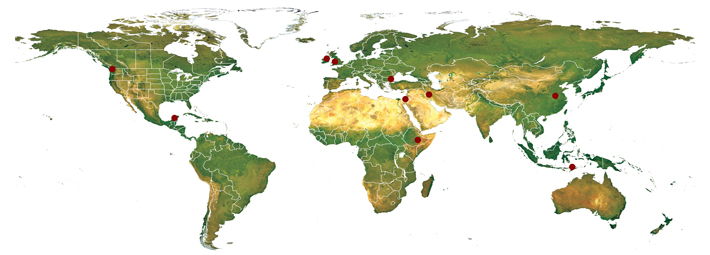

-
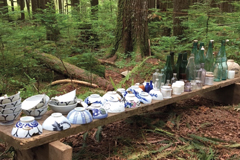 CANADA: Remnants of a forgotten early 20th-century Japanese village were uncovered deep in the forest outside Vancouver. They include 14 houses, a possible shrine, and a bathhouse, along with an assortment of Japanese ceramics. The small settlement likely began as a logging camp, but community members may have chosen to remain even after logging ceased in order to avoid widespread anti-Japanese sentiment. The village’s sudden abandonment was, perhaps, the result of Canada’s establishment of Japanese internment camps in early 1942.
CANADA: Remnants of a forgotten early 20th-century Japanese village were uncovered deep in the forest outside Vancouver. They include 14 houses, a possible shrine, and a bathhouse, along with an assortment of Japanese ceramics. The small settlement likely began as a logging camp, but community members may have chosen to remain even after logging ceased in order to avoid widespread anti-Japanese sentiment. The village’s sudden abandonment was, perhaps, the result of Canada’s establishment of Japanese internment camps in early 1942. -
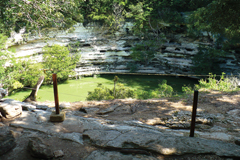 MEXICO: A millennium ago in Chichen Itza, the Maya practiced ritual human sacrifice. Scholars have long debated whether locals or outsiders were subjected to this grim fate. Using the results of isotope analysis of tooth enamel from sacrificial victims thrown into the site’s Sacred Cenote, researchers have concluded that some grew up locally, while others hailed from the Gulf Coast, the Central Highlands, and as far away as Central America. It is unknown whether those born farther away were slaves, prisoners of war, or immigrants to the city.
MEXICO: A millennium ago in Chichen Itza, the Maya practiced ritual human sacrifice. Scholars have long debated whether locals or outsiders were subjected to this grim fate. Using the results of isotope analysis of tooth enamel from sacrificial victims thrown into the site’s Sacred Cenote, researchers have concluded that some grew up locally, while others hailed from the Gulf Coast, the Central Highlands, and as far away as Central America. It is unknown whether those born farther away were slaves, prisoners of war, or immigrants to the city. -
 IRELAND: A farmer in County Meath who long suspected something curious existed beneath his field was proved right—a recent investigation revealed clues about his land’s surprising medieval occupants. French pottery, a grain-drying oven, and other artifacts are evidence of an unusual community of French Cistercian monks who moved to Ireland around the 13th century. Instead of founding a typical monastery, though, the monks established a grange, raising sheep and growing crops that they sent back to their home monastery of De Bello Becco in Normandy.
IRELAND: A farmer in County Meath who long suspected something curious existed beneath his field was proved right—a recent investigation revealed clues about his land’s surprising medieval occupants. French pottery, a grain-drying oven, and other artifacts are evidence of an unusual community of French Cistercian monks who moved to Ireland around the 13th century. Instead of founding a typical monastery, though, the monks established a grange, raising sheep and growing crops that they sent back to their home monastery of De Bello Becco in Normandy. -
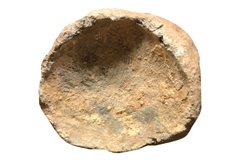 ENGLAND: Nearly 100 military objects were retrieved from the site of the Battle of Worcester, the pivotal and final episode of the English Civil War. The artifacts left strewn across the field include musket balls, pistol shot, gun parts, and belt buckles. Almost 45,000 soldiers clashed in the 1651 engagement, during which Oliver Cromwell and his Parliamentarian New Model Army routed the Royalist forces, causing King Charles II to flee and temporarily interrupting the rule of the English monarchy.
ENGLAND: Nearly 100 military objects were retrieved from the site of the Battle of Worcester, the pivotal and final episode of the English Civil War. The artifacts left strewn across the field include musket balls, pistol shot, gun parts, and belt buckles. Almost 45,000 soldiers clashed in the 1651 engagement, during which Oliver Cromwell and his Parliamentarian New Model Army routed the Royalist forces, causing King Charles II to flee and temporarily interrupting the rule of the English monarchy. -
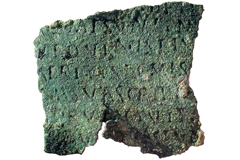 BULGARIA: Part of a Roman soldier’s military diploma was found during excavations in the ancient city of Deultum near the Black Sea. These documents were issued to auxiliary troops upon completion of 25 years of military service, at which point they were, finally, awarded Roman citizenship. The small bronze fragment contains an excerpt of a decree issued by the emperor Hadrian in A.D. 122 ordering soldiers in the province of Dacia Inferior (modern Romania) to be discharged from their service.
BULGARIA: Part of a Roman soldier’s military diploma was found during excavations in the ancient city of Deultum near the Black Sea. These documents were issued to auxiliary troops upon completion of 25 years of military service, at which point they were, finally, awarded Roman citizenship. The small bronze fragment contains an excerpt of a decree issued by the emperor Hadrian in A.D. 122 ordering soldiers in the province of Dacia Inferior (modern Romania) to be discharged from their service. -
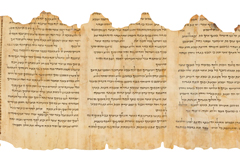 ISRAEL: Having been buried in caves for almost 2,000 years, the Dead Sea Scrolls have survived in various states of preservation. One of them, called the Temple Scroll, is particularly notable for its fine condition. New chemical analysis of the scroll has revealed that it was made differently from the others. During the parchment’s manufacture, the surface was covered with a mixture of sulfate salts, which has helped the scroll and its text survive.
ISRAEL: Having been buried in caves for almost 2,000 years, the Dead Sea Scrolls have survived in various states of preservation. One of them, called the Temple Scroll, is particularly notable for its fine condition. New chemical analysis of the scroll has revealed that it was made differently from the others. During the parchment’s manufacture, the surface was covered with a mixture of sulfate salts, which has helped the scroll and its text survive. -
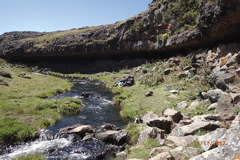 ETHIOPIA: Given the harsh conditions, it’s notoriously difficult for humans to live at extreme altitudes. This did not deter some of our ancient ancestors. Evidence shows that humans were living at least 11,000 feet above sea level in the Bale Mountains some 40,000 years ago. Hearths, stone tools, animal bones, and human feces from the Fincha Habera rock shelter comprise the earliest-known evidence of a high-altitude residential site. It is believed that humans survived there by eating giant mole rats and drinking water from glacial runoffs.
ETHIOPIA: Given the harsh conditions, it’s notoriously difficult for humans to live at extreme altitudes. This did not deter some of our ancient ancestors. Evidence shows that humans were living at least 11,000 feet above sea level in the Bale Mountains some 40,000 years ago. Hearths, stone tools, animal bones, and human feces from the Fincha Habera rock shelter comprise the earliest-known evidence of a high-altitude residential site. It is believed that humans survived there by eating giant mole rats and drinking water from glacial runoffs. -
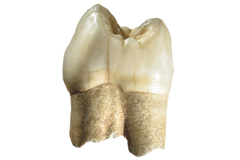 IRAN: It turns out that a fossilized tooth found decades ago in the Zagros Mountains did not belong to a modern human as previously thought, but rather to a Neanderthal child who lived between 70,000 and 40,000 years ago. A recent reexamination using modern techniques established the new dating and identification. The researchers say it is the first evidence that Neanderthals once lived in this area of present-day Iran. The species roamed across much of Europe and Western Asia before going extinct 40,000 years ago.
IRAN: It turns out that a fossilized tooth found decades ago in the Zagros Mountains did not belong to a modern human as previously thought, but rather to a Neanderthal child who lived between 70,000 and 40,000 years ago. A recent reexamination using modern techniques established the new dating and identification. The researchers say it is the first evidence that Neanderthals once lived in this area of present-day Iran. The species roamed across much of Europe and Western Asia before going extinct 40,000 years ago. -
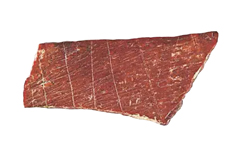 CHINA: Obscure engravings on animal bones from the site of Lingjing in Henan Province suggest that early hominins who lived there 125,000 years ago may have had more advanced cognitive abilities than once believed. The mysterious markings proved to have been etched into the bone, which was then rubbed with red ochre powder to make the markings more visible. Experts do not yet know why early humans made these abstract designs, nor what they represent.
CHINA: Obscure engravings on animal bones from the site of Lingjing in Henan Province suggest that early hominins who lived there 125,000 years ago may have had more advanced cognitive abilities than once believed. The mysterious markings proved to have been etched into the bone, which was then rubbed with red ochre powder to make the markings more visible. Experts do not yet know why early humans made these abstract designs, nor what they represent. -
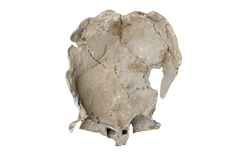 INDONESIA: The first modern humans in Australia may have migrated there from Southeast Asia via the islands of Indonesia. Two new skull fragments from Alor Island, dating to between 17,000 and 12,000 years ago, hint that the Wallacean Islands may have been a stop on this migration route. One peculiar aspect of these skulls is their small size. This may be due to the “island effect.” This theory posits that when humans and other mammals live on islands lacking sufficient nutrition, they gradually become smaller.
INDONESIA: The first modern humans in Australia may have migrated there from Southeast Asia via the islands of Indonesia. Two new skull fragments from Alor Island, dating to between 17,000 and 12,000 years ago, hint that the Wallacean Islands may have been a stop on this migration route. One peculiar aspect of these skulls is their small size. This may be due to the “island effect.” This theory posits that when humans and other mammals live on islands lacking sufficient nutrition, they gradually become smaller.
Advertisement
IN THIS ISSUE
From the Trenches
Proof Positive
Off the Grid
The Wrath of the Hittites
Melting Season
Provincial Pen Pal
Megalithic Mystery
Worlds Apart
The Lead Standard
Egypt's Temple Town
Æthelburga's Local Church
Down by the River
Rise of the Greek Crane
Jetting Across the British Isles
World Roundup
Island hopping to Australia, Dead Sea Scroll survival, Roman social security, and the village Canada forgot
Artifact
Another face in the crowd
Advertisement

Recent Issues
-
 May/June 2024
May/June 2024
-
 March/April 2024
March/April 2024
-
 January/February 2024
January/February 2024
-
 November/December 2023
November/December 2023
-
 September/October 2023
September/October 2023
-
 July/August 2023
July/August 2023
-
 May/June 2023
May/June 2023
-
 March/April 2023
March/April 2023
-
 January/February 2023
January/February 2023
-
 November/December 2022
November/December 2022
-
 September/October 2022
September/October 2022
-
 July/August 2022
July/August 2022
-
 May/June 2022
May/June 2022
-
 March/April 2022
March/April 2022
-
 January/February 2022
January/February 2022
-
 November/December 2021
November/December 2021
-
 September/October 2021
September/October 2021
-
 July/August 2021
July/August 2021
-
 May/June 2021
May/June 2021
-
 March/April 2021
March/April 2021
-
 January/February 2021
January/February 2021
-
 November/December 2020
November/December 2020
-
 September/October 2020
September/October 2020
-
 July/August 2020
July/August 2020
-
 May/June 2020
May/June 2020
-
 March/April 2020
March/April 2020
-
 January/February 2020
January/February 2020
-
 November/December 2019
November/December 2019
-
 September/October 2019
September/October 2019
-
 July/August 2019
July/August 2019
-
 May/June 2019
May/June 2019
-
 March/April 2019
March/April 2019
-
 January/February 2019
January/February 2019
-
 November/December 2018
November/December 2018
-
 September/October 2018
September/October 2018
-
 July/August 2018
July/August 2018
-
 May/June 2018
May/June 2018
-
 March/April 2018
March/April 2018
-
 January/February 2018
January/February 2018
-
 November/December 2017
November/December 2017
-
 September/October 2017
September/October 2017
-
 July/August 2017
July/August 2017
-
 May/June 2017
May/June 2017
-
 March/April 2017
March/April 2017
-
 January/February 2017
January/February 2017
-
 November/December 2016
November/December 2016
-
 September/October 2016
September/October 2016
-
 July/August 2016
July/August 2016
-
 May/June 2016
May/June 2016
-
 March/April 2016
March/April 2016
-
 January/February 2016
January/February 2016
-
 November/December 2015
November/December 2015
-
 September/October 2015
September/October 2015
-
 July/August 2015
July/August 2015
-
 May/June 2015
May/June 2015
-
 March/April 2015
March/April 2015
-
 January/February 2015
January/February 2015
-
 November/December 2014
November/December 2014
-
 September/October 2014
September/October 2014
-
 July/August 2014
July/August 2014
-
 May/June 2014
May/June 2014
-
 March/April 2014
March/April 2014
-
 January/February 2014
January/February 2014
-
 November/December 2013
November/December 2013
-
 September/October 2013
September/October 2013
-
 July/August 2013
July/August 2013
-
 May/June 2013
May/June 2013
-
 March/April 2013
March/April 2013
-
 January/February 2013
January/February 2013
-
 November/December 2012
November/December 2012
-
 Sep/Oct 2012
Sep/Oct 2012
-
 September/October 2012
September/October 2012
-
 July/August 2012
July/August 2012
-
 May/June 2012
May/June 2012
-
 March/April 2012
March/April 2012
-
 January/February 2012
January/February 2012
-
 November/December 2011
November/December 2011
-
 September/October 2011
September/October 2011
-
 July/August 2011
July/August 2011
-
 May/June 2011
May/June 2011
-
 March/April 2011
March/April 2011
-
 January/February 2011
January/February 2011
Advertisement






